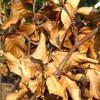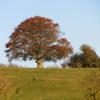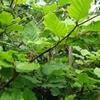Great choice! We're adding your items to the basket and working out what else you might need to plant it.
Common Beech Fagus sylvatica
Example photos only. Size, stem height and habit may vary.
Please contact us for photos of current stock.
Select plant type
Quantity
| Volume Discount | 1+ | 10+ | 50+ | 250+ |
|---|---|---|---|---|
| 5L pot / 40-60cm | £18.00 | £16.20 | £14.40 | £12.60 |
| 10L pot / 150-175cm | £39.00 | £36.00 | £33.60 | £31.20 |
British Grown – The British Grown logo denotes plants and trees that have been both propagated and grown in the UK. Read more
Product Description
FAGUS SYLVATICA - Beech
Characteristics
Beech is one of the most impressive European trees. It is traditionally a key forest tree of the temperate zone of western and central Europe, representing the last stage in the natural succession of a woodland. It forms the backbone of dramatic forests of elegant smooth trunks and tiered branches of foliage that changes from fresh spring green to vibrant autumn coppers.
Solitary beech trees have a wide, dense crown and low branches which hang down. As a tree in avenues or forests, it develops a dead straight trunk with branches high above the ground. Trees more than 40m (130ft) tall or 30m (100ft) wide are not uncommon. The leaves are oval, green and grow quickly from their cigar-shaped buds in the first week of May.
As a consequence of the young tree's ability to hold onto its dead leaves in the winter, one of the most common uses of beech is for formal hedging. Keeping the hedge cut below 3m (10ft) preserves this phenomenon and gives the hedge all-year cover, green from May to November, orange-brown the rest of the year.
Where to grow
Beech can be difficult to establish. Unlike most trees, it is only after bud burst that root growth, for that year, begins. The first roots to appear are very thin (with a diameter of less than 0.5 mm). Later, after a wave of aboveground growth, thicker roots grow in a steady fashion.
Beech prefers humus rich, light or medium soils, and will not tolerate a waterlogged root zone for any length of time. However during the establishment phase their root systems must not be allowed to dry out and regular watering is needed. This balance is crucial to planting success.
Did you know?
Beech is classified as a native in the south of England and as a non-native in the north. Recent evidence in fact suggests that Fagus sylvatica did not arrive in England until about 4000 BC, or 2,000 years after the English Channel formed after the ice ages. It could have been an early introduction by Stone Age man, who used the nuts for food. Beech forests can be found at Savernake in Wiltshire and the Chiltern Hills in Buckinghamshire.
Features
-
Mature Height
- Very Large - 20 metres+
-
Spread
- 15-20 metres
-
Shape / Habit
- Spreading
- Broad headed
-
Growth Rate
- Slow
-
Soil Type
- Chalk/Limestone
- Light sandy
-
Sun Levels
- Full sun
- Partial shade
-
Difficulty / Hard to Grow
- Medium
-
Evergreen / Deciduous
- Deciduous
-
Autumn Colour
- Orange
- Yellow
-
Leaf Colour
- Green
-
Foliage
- Dense
- Small leaves
-
Uses
- Screening
- Parkland Tree
- Garden Tree
- City/Urban Sites
- Country/Farmland
- Good Firewood
- Timber producing
- Wind break
-
Hedging
- Native Hedge
- Holds its leaves
-
Native / Naturalised
- Native
-
Season
- Autumn
- Summer
-
Other Features
- Good at altitude
Aftercare
Pruning Fagus sylvatica
Fagus sylvatica has relatively shallow roots for its eventual size. Training well ensures a sturdy frame that will offer stability once established. When the tree is young do not over prune as the laterals protect the young central leader from sun scorch. Grow with a strong central leader, removing any strong laterals that may compete. Over time a clear trunk of 3m can be reached.
If grown as a hedge, clip annually in midwinter.
What time of year is best for pruning? Prune in winter when the tree is dormant. Pruning is possible in summer if necessary.
For the continued healthy growth of your trees, shrubs or hedging it is vital that you follow the advice below.
Watering
The main reason that plants die within 12 months of having been planted is lack of water. It is essential throughout the spring and summer, to give a heavy enough watering to enable the water to penetrate right down to the deepest root level of the tree. In hot dry spells give the equivalent of 2 bucketfuls every three days.
Weed Control
One of the most common causes of lack of water is competition from grass. When trees are first establishing, the grass roots would be at the same level as the tree roots and are far more efficient at taking up water and thus choke the tree. It is vital that for at least 3 years after planting your tree or hedge has a circle or strip one metre wide completely free of grass.
- Mulch mats are an effective way to stop grass and weeds, although they will require a careful eye to make sure they continue to work. After clearing the ground around the tree, firmly fit the mat by tucking the edges into the soil and put a thick layer of bark mulch on top of this. Be careful not to allow the woodchip to touch the stem as it can cause rot.
- Weed killer is very effective, however it is harmful to the environment. Organic weed killers usually do not kill roots. Weed killer needs to be applied each year for the first 3 years, preferably when the tree is dormant, or just once before applying a mulch mat.
- Mowing or strimming is NOT an answer to the problem. Each time you mow, the grass will grow back more vigorously and strimming invariably leads to lacerated trunks.
Staking
If trees are not correctly secured they will rock in the planting pit. Roots not firmly in contact with the soil are unable to take up moisture and nutrients, resulting in die back or death of the tree. Check, particularly after windy weather, that stakes are still solidly in the ground keeping the base of the trunk firm. The purpose of the stakes is to anchor the roots. Flexing in the wind, higher up the trunk, is not necessarily a problem if the roots are firm.
Bellow is list of the correct system to use to secure your trees.
- 40/60, 60/80, 80/100 whips - Unless rabbit/deer problem no need to stake.
- 100/125, 125/150 1.2m Cane and Easi tie.
- 150/175 1.2m square stake and a buckle tie and spacer.
- 175/250, 6/8, 8/10 15L 1.65 Tree stake and a buckle tie and spacer.
- All larger trees. 2 x 1.65 Tree stake and cross rail with 38mm cushion spacer and 1m of 38mm strapping.
Ties
Always use our recommended tree ties or strapping. These are designed and manufactured with the correct amount of give to hold the tree firm without strangling it. They should be checked at the end of each growing season for adjustment as the trunk thickens. Non proprietary materials such as baler twine will cut into the bark and should not be used.
Protection from Animal Damage
Rabbits, deer, sheep, cattle and horses can all potentially damage trees. Ask us for advice on the most appropriate guards for your trees or hedge. Squirrels are also a terrible pest when trees get to about 20ft tall but there is no protection available.
Are the delivery costs the same no matter how many plants I order?
Yes the delivery costs stay the same no matter how many plants you have on your order. They are worked out based on your distance from our nursery and can be found here.





